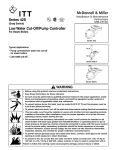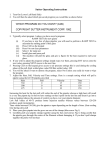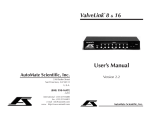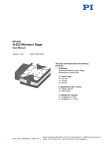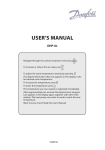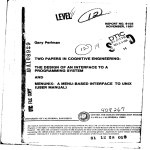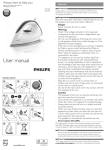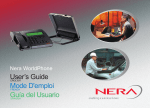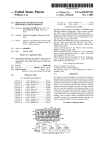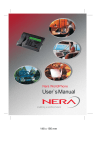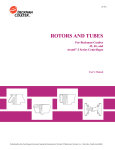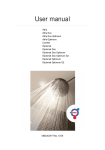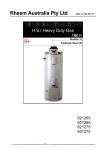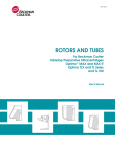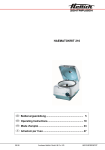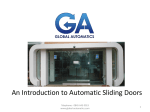Download DMZ-Universal Puller
Transcript
DMZ-Universal Puller ________________________________________________ ___________________________________________________________________________________________ August 2005 800.998.MATE | www.autom8.com | 812 Page St, Berkeley, CA 94710 USA tel 510.845.6283 | fax 510.280.3795 | e-mail [email protected] DMZ-Universal Puller ________________________________________________ USER'S MANUAL PRECAUTIONS DANGER! For continued protection against fire hazard: In no way, do not cover the instrument, even if it is switched off!! DANGER! Disconnect the power cord before attempting any maintenance! Dangerous voltages inside the instrument. Refer servicing to qualified personnel! DANGER! Fingers can be jammed and burned or eyes injured by glass splinters when the heater appears or retracts! Warning! This equipment is not intended for use in human application or human experimentation! Warning! The filament is very hot (1000 °C). Warning! Replace only with the same rating of fuse! DANGER!! FIRE HAZARD! Even when not in use, do not cover! ___________________________________________________________________________________________ August 2005 Zeitz-Instruments GmbH, Muenchen, Germany, Hot-Line+49 0172 8125656 www.zeitz-puller.com [email protected] DMZ-Universal Puller ________________________________________________ Table of contents 1 Features of the puller 4 2 2.1 3 3.1 3.2 3.21 First steps First steps: detailed description The puller controls The right-hand side of the control panel The left-hand side of the control panel The function keys 7 8 11 11 11 12 4 4.1 4.2 4.3 Descriptions of the programs Single-pull programs Multi-pull programs Polishing patch electrodes 14 14 15 15 5 5.1 5.2 5.3 Using the puller Examples of programs Effect of changes in program parameters Understanding the pulling procedure Diagram 1 Diagram 2 Diagram 3 Fig. 1, Fig. 2, Fig 3 17 17 17 17 19 20 21 22 6 Tables Table 1 a: b: 23 24 Summary of programs P00 - P09 Summary of programs P10 - P19 Detailed description, Program P10 Detailed description, Program P11 Detailed description, Program P12 Detailed description, Program P13 7 7.1 7.2 7.3 25 26 27 28 Table 2: Effect of changes in puller parameters Explanations and comments to Table 2 Maintenance Cleaning the pulling rod Lubricating the threaded spindle of the heaterpositioning motor Replacing the heating filament 29 30 33 33 33 35 ___________________________________________________________________________________________ August 2005 Zeitz-Instruments GmbH, Muenchen, Germany, Hot-Line+49 0172 8125656 www.zeitz-puller.com [email protected] DMZ-Universal Puller ________________________________________________ 8 8.1 8.2 9 Troubleshooting The glass breaks in the glass holders Rattling motor noise Figures Fig. 1: Fig. 2: Fig. 3: Fig. 4: Fig. 5: 37 37 39 Overview of the puller and its controls The puller's mechanical components The puller's circuitry Close-up view of the glass holders The heater's mechanical components 10 Frequently Asked Questions 11 Circuit Diagrams 45 45 46 46 47 ___________________________________________________________________________________________ August 2005 Zeitz-Instruments GmbH, Muenchen, Germany, Hot-Line+49 0172 8125656 www.zeitz-puller.com [email protected] DMZ-Universal Puller ________________________________________________ 1 Features of the puller The puller has the following fully microprocessor-controlled variables: 1. 2. 3. 4. 5. Distance of pull (longitudinal) Force of pull (time-controlled program) Force of pull (distance-controlled program) Time- or distance-controlled heat application Power of the heat actually radiated by the filament, regulated by an optical (ultrared) sensor The puller features: 80 programs. ♦ Permanent storage of ♦ One- or two-stage pulling programs, in which all variables can be set independently for each stage, with the option of repeating the first stage. ♦ Full automation. There is no risk of breaking even thin-walled capillary glass in the glass holders because the clamping of the glass in the holders is carried out by two micromotors which result in precisely defined clamping forces. ♦ Choice of capillary glass outer diameter of 1 - 2 mm. ♦ Symmetrical pipette tips in multi-pull programs (one, two or three preliminary pulls, up to nine preliminary pulls from the Ser.N° up beginning with 25 ..). This is achieved by readjustment (centring) of the position of the glass tubing relative to the heating filament after each stage of the pull. ♦ Automatic (programmable) control of the duration of heating. This is achieved by automatic positioning (advance or withdrawal) of the "U"-shaped heating filament relative to the glass, thus avoiding the need for air-jet cooling. ♦ Compensation for variations in the wall thickness of the glass tubing. This is achieved by the (programmable) inclusion in the pulling programs of a phase in which the stiffness of the tubing is sensed during pulling. ♦ Free choice and absolute reproducibility of tip diameter (down to 0.1 µm), taper and electrode resistance (up to 100 MΩ). ___________________________________________________________________________________________ August 2005 Zeitz-Instruments GmbH, Muenchen, Germany, Hot-Line+49 0172 8125656 www.zeitz-puller.com [email protected] DMZ-Universal Puller ________________________________________________ ♦ Especially suitable for pulling patch electrodes of precisely defined tip o.d. (usually 1 80 µm). The puller will also heat polish the electrode tips after pulling. ♦ Canthal® heating filaments. This material is extremely durable, but the heating filaments can nevertheless be changed easily. ♦ Electrode tip sizes and shapes are relatively (compared with other pullers) independent of the precise shape and position of the heating filament. Repeated, time-consuming readjustment of the heating filament is thus not necessary. ♦ The excellent reproducibility of electrode tip characteristics (even over months) means that electrodes can be made as required, immediately before use. Prefabrication of large numbers of electrodes well in advance of an experimental series is no longer required. ___________________________________________________________________________________________ August 2005 Zeitz-Instruments GmbH, Muenchen, Germany, Hot-Line+49 0172 8125656 www.zeitz-puller.com [email protected] DMZ-Universal Puller ________________________________________________ WARNING: This equipment is not intended for use in human application or human experimentation! The documentation accompanying the puller consists of two parts: 1. First steps. Brief instructions for setting the puller in operation and making your first pipettes. These instructions are followed by more detailed descriptions, which also refer to the second part of the documentation (the user's manual). 2. The User's Manual, containing a complete and detailed description of the puller, its components and functions. ___________________________________________________________________________________________ August 2005 Zeitz-Instruments GmbH, Muenchen, Germany, Hot-Line+49 0172 8125656 www.zeitz-puller.com [email protected] DMZ-Universal Puller ________________________________________________ 2 FIRST STEPS This section of the documentation tells you how to produce your first pipettes within minutes of unpacking the puller. NB.: In the puller documentation, the various controls on the puller are always written in bold, in exactly the same way that they appear on the puller, e.g. MAINS. The table and figures to which reference is made below are in the User's Manual. Make your first pipette: 1. Ensure the power cord is connected and switch on the puller by pressing MAINS. 2. Insert a glass blank GC 150 TF (not GC 150 F!) into the two open glass holders, taken from the box supplied. 3. Select a program (program 10): press P(A), then enter 10 on the numeric keypad. 4. Press START. 5. After the pipettes have been pulled, the glass holders still hold the pipettes. Press START again. The puller heat-polishes the right-hand pipette. When this is concluded, remove the right-hand pipette from the reopened glass holder. Press START yet again. The puller heat-polishes the left-hand pipette. When this is concluded, remove the left-hand pipette from the reopened glass holder. ___________________________________________________________________________________________ August 2005 Zeitz-Instruments GmbH, Muenchen, Germany, Hot-Line+49 0172 8125656 www.zeitz-puller.com [email protected] DMZ-Universal Puller ________________________________________________ 2.1 First steps: detailed description 1. Ensure the power cord is connected. Switch on the puller by pressing MAINS. The pulling rod moves to the right to the "ready" position. 2. Select a program from Table 1 (User's Manual). Here program no. 10 (P10) has been used. Table 1 shows the settings of all puller parameters for the 20 standard programs for various electrodes and glass types. These programs are already installed by the manufacturer, but may be modified at will. Check the width of the heating filament in the puller. Please note that the programs P00 - P13 use a 3-mm-wide heating filament, the programs P14 - P19 a 4.5-mm-wide filament. This, too, may be varied as desired. The 3-mm filament is installed by the manufacturer and spare filaments of both sizes are supplied in the spare-parts box (for changing the filament see section 6.3 in the User's Manual, "Replacing the heating filament"). The 4.5-mm heating filament is recommended for pulling glass with an o.d. of 2 mm or aluminosilicate or common soda glass. 3. Open the Perspex lid, insert a glass pipette blank (type GC150 T or GC150TF, taken from the box supplied) into the open glass holders so that it rests on the two bearing surfaces (see Fig. 4, 1). NB: Should the glass holders be closed when attempting to insert a blank (as would be the case if the puller had been started without a glass blank in place) press READY, then BREAK and, after some seconds, READY again (these are the large, illuminated switches at the right-hand side of the control panel). The glass holders should now be completely open. If not, repeat the procedure. 4. Press P(A) (Fig. 1, 9) and enter the corresponding number of the program (here 1 0) on the numeric keypad (Fig. 1, 11). In the display 10 should appear, confirming that program no. 10 is now activated. N.B.: Before proceeding further, deactivate the tip polishing process which would normally follow pulling. Press P(B) and then AD; a three-digit number (xyz) will appear in the display. Press 0 (zero) on the numeric keypad and "enter" by pressing E (the enter key). The display should now show 0yz. If you make a mistake, clear the display (press C) press the correct numbers (0 y z) and enter (press E) See also point 5 below. Caution! The heater appears! Close the Perspex lid and press START (illuminated switch on the right). The glass holders close automatically and heating begins. The pipette blank will be elongated a little by the heat and the preliminary pull, after which it is centred. The pulling and centering is repeated ___________________________________________________________________________________________ August 2005 Zeitz-Instruments GmbH, Muenchen, Germany, Hot-Line+49 0172 8125656 www.zeitz-puller.com [email protected] DMZ-Universal Puller ________________________________________________ before the final pull which separates the two pipettes. Both glass holders now open and the finished pipettes can be removed (see description of programs). This is an example of a program with a total of three pulls, the first two of which were concerned with the preliminary centering and elongation (two preliminary pull program, see Table 1, note 2). 5. Polishing. The puller may be used to polish patch electrodes after pulling. To activate the polishing process, it is necessary to alter one of the parameters stored in the puller before starting the pulling. This is done simply as follows: Press P(B) and AD. The number 0yz should appear in the display (see point 4 above). Change this by pressing 2 and then E (= enter) on the numeric keypad. The display should now show 2yz. If you make a mistake clear the display and enter the correct number (C 2 y z E) via the numeric keypad. Entering the value 2 has changed 0yz into 2yz. This indicates a polishing duration of 2 s at a heating current of yz0 (see Table 1, note 4). Two ranges (low and normal) of heating strength for the polishing process are available (see Table 1, note 3 and section 2.2, the description of the controls on the left-hand side of the control panel, in the User's Manual). To pull and polish electrodes choose the same type of glass blank as before (GC150 T or GC150 TF). Press READY, insert the glass blank into the glass holders, close the Perspex lid and press START. In this case the glass holders now do not open after pulling. Press START again. The right-hand holder moves automatically a little to the right so that when the heating filament subsequently moves into outside position it encloses the tip in the middle of its curved surface. The heater now moves to the outer position and heatpolishes the right-hand pipette. When this is concluded the right-hand glass holder will open automatically, allowing the polished pipette to be removed. Press START yet again. The left-hand pipette moves into the polishing position and is heat polished, after which the holder opens and the pipette can be removed. The polishing parameters can be altered before pulling by using the keys P(A), t(H) and s(H) (see Table 1, notes 5 and 6 and description of program 10). Values between 001 and 090 are recommended. The values actually set can be displayed by pressing P(A) and then t(H) or s(H) and changed when the puller is in the "ready" condition. The polishing parameters cannot be changed after starting the pulling/polishing process. Once started, the polishing process can be aborted only by switching off the puller. To deactivate the polishing process in a program press, before starting the pulling program, P(A) and AD (the display should show 2yz, see above) and then 0 and E on the numeric keypad (the display should now show 0yz). If you make a mistake press C (clear), 0 y z E (enter) on the numeric keypad (see also point 4 above). ___________________________________________________________________________________________ August 2005 Zeitz-Instruments GmbH, Muenchen, Germany, Hot-Line+49 0172 8125656 www.zeitz-puller.com [email protected] DMZ-Universal Puller ________________________________________________ N.B.: Pulling glass with a 2-mm o.d. (e.g. GC 200). Occasionally, and particularly after pulling thinner glass, the glass holders may not open wide enough to accept 2-mm o.d. blanks. If this should occur, press READY then BREAK, and after a delay of some seconds, READY again. The glass holders should now open completely. Use the same procedure if the glass holders are closed when you wish to insert a blank (as would be the case if a pulling program had been started without glass in the holders). N.B.: Should the heating filament be positioned in front of the glass holders (and thus prevent normal insertion of a glass blank) DO NOT, under any circumstances, attempt to insert a glass blank into the holders by pushing it through from the right (and thus through the filament). Instead, switch off the puller (MAINS), wait 20 s then switch on again. The heater will assume its rest position, after which you can insert the glass blank normally. If this has happened, do not forget to reselect your program, because switching off and on resets the selected program to P00. 6. Suggestions for variations to program. (Example is program P10). Smaller tip diameters may be achieved by increasing the heating current for the final pull. Press P(B) then H. The display shows, say, 105. Increase this value to e.g. 115 by pressing 1 1 and E on the numeric keypad; the display should now show 115. If you make a mistake clear the display and enter the correct number (C 1 1 5 E). A further means of achieving smaller tips is to decrease the pulling delay. Press P(B) then t(F1). The display shows, say, 120. Decrease this value to e.g. 110 by pressing 1 1 E on the numeric keypad. If you make a mistake clear the display and enter the correct number (C 1 1 0 E). WARNING: This equipment is not intended for use in human application or human experimentation! ___________________________________________________________________________________________ August 2005 Zeitz-Instruments GmbH, Muenchen, Germany, Hot-Line+49 0172 8125656 www.zeitz-puller.com [email protected] DMZ-Universal Puller ________________________________________________ 3 The puller's controls The two groups of controls are located on the sloping top panel of the instrument. This panel is hinged (Fig.1, 1 and 2) to allow service access. On the right hand side is the group of illuminated switches and indicators controlling individual pulls, on the left are keys defining the variables and a numeric keypad. These are used to select (and alter if necessary) the 80 stored programs and the time sequence of the pulls. 3.1 The right-hand side of the control panel The puller is switched on and off using the MAINS switch (3). The lower keys bring the puller into a state of readiness (READY, 4), start a pull (START, 5) or, in case of trouble, interrupt the pull sequence (BREAK, 6). The latter lights up when the program detects a disturbance in the pulling sequence which stops the program. The stages of the pulling sequence are indicated by the real time counter (7, 100-ms units from the start of the pull) and the lamps (8) which light up at various critical points within the sequence: "F(TH)" is lit as long as the heater is on and a small sensing or preliminary or sensing pull is operating. It is extinguished when a (programmable) threshold extension is reached. At this point "(TH)" lights up. "F1" is lit when the first phase of the main pull begins, "F2" lights up when the second phase of the main pull begins. 3.2 The left-hand side of the control panel Pressing the keys P(A) or P(B) (9) causes the number (e.g. P14) of the last-used program to appear in the display (10). To change the program selected simply type the appropriate number (e.g. 0 9) on the numerical keypad (11), it will appear in the display (10). Note: The programs P00, P09, P10, P11, P12, and P13 have been tested in each individual puller and the values of the parameters stored in the memory adjusted to achieve the specified tip characteristics (see table). The numeric values may thus deviate slightly from the values both in the table and in any numeric examples given in the manual. The keys P(A) and P(B) (9) further define the effects of pressing the function keys (12, see also section 3, Description of programs). Depressing a function key (12) causes the value set for this variable in the current program to appear in the display (10). If the value of this variable is to be changed, simply type the new numerals (from left to right) on the numeric keypad (11) and press E (enter). The new value will appear in the display (10). For example, to change the value 214 to 014 press 0 and E. If a mistake is made, clear the display (C) and enter the whole new number (the entire sequence would then be C 0 1 4 E). 3.21 The function keys ___________________________________________________________________________________________ August 2005 Zeitz-Instruments GmbH, Muenchen, Germany, Hot-Line+49 0172 8125656 www.zeitz-puller.com [email protected] DMZ-Universal Puller ________________________________________________ • Note 1: In the following, "H" always refers to the heating power, "F" to the force applied to the pulling rod, "s" to the distance moved by the rod and "t" to a time interval. • Note 2: The DMZ Universal Puller employs three types of pull: a low force pull (termed sensing), which is used to compensate for variations in glass dimensions a series (up to three) of relatively low force pulls (termed preliminary) used to produce specified elongations of the glass a final or main pull (F1 and F2), which may have two phases and which finally separates the two pipettes. 1. 2. 3. Heat, H: The value can be set between 000 and 999. The actual power of the radiated heat is measured by an ultrared photosensor, and is proportional to the value set. Force Preliminary Pull, F(TH): The voltage applied to the force coil during a preliminary or sensing pull is proportional to the value set here (020 -100). When P(A) is chosen, F(TH) is a weak preliminary pull - point 2 above - and when P(B) is lit, F(TH) is the sensing pull - point 1 above. Distance Threshold s(TH): The value set here (001-080, unit 0.12 mm) is the distance moved by the pulling rod before the preliminary or sensing pull is terminated. Delay Heatstop, t(H): The value set here (000 - 999, unit 0.5 ms) is the delay between the end of the sensing pull and switching off the heating (and retracting the heating filament). This function is valid only if s(TH) = 000. This key also determines the position (distance) of the right-hand electrode when polishing (see Table 1, note 5). [The value is displayed, and can be altered only when P(A) is activated. Values are 000 - 080]. Distance Heatstop, s(H): The value set here (000 - 127, unit 0.12 mm) is the position (of the pulling rod) at which the heating is terminated and the filament retracted, after the pulling rod has reached the position [s(TH)] at which the sensing pull is terminated. This function is available only if t(H) = 000. This key also determines the position of the left-hand electrode when polishing (see Table 1, note 6). [The value is displayed and can be altered only when P(A) is activated, at 000 080]. Delay Pull 1, t(F1): The value set here (000 - 999, unit 0.5 ms) is the delay between the end of the sensing pull and the start of phase 1 of the main pull. ___________________________________________________________________________________________ August 2005 Zeitz-Instruments GmbH, Muenchen, Germany, Hot-Line+49 0172 8125656 www.zeitz-puller.com [email protected] DMZ-Universal Puller ________________________________________________ Force Pull 1, F1: The voltage applied to the force coil during phase 1 of the main pull is proportional to the value set here (000 - 999). Distance Pull 2, s(F2): The value set here (000 - 127, unit 0.12 mm) is the distance between the position of the pulling rod at the start of phase 1 of the main pull ( i.e., the position at the end of the sensing pull) to the position of the pulling rod at the start of phase 2 of the main pull. Force Pull 2, F2: The voltage applied to the force coil during phase 2 of the main pull is proportional to the value set here (000 - 999). Adjust, AD: 1. When P(A) is pressed: Value X0X: (X = any value except 0); no preliminary pull (this only when P(A) is pressed, see Table 1, note 2). Value 0X0: normal heating range (during main pull and polishing, see Table 1, notes 1 and 3). Value XYZ: X = 1: low heating range at final pull with more precise control of heating strength (see examples Table 1). Y = 1: one preliminary pull. Y = 2: two preliminary pulls. Y = 3: three preliminary pulls (see also Table 1, note 2). Y = 4 ... 9 four to nine preliminary pulls. Z = 1: low heating range during polishing, with more precise control of heating strength (see Table 1, note 3). 2. When P(B) is pressed: Value 000: no polishing. See Table 1 note 4). Value XYZ: the duration of heat application during polishing is proportional to X; the heating power to YZ (see Table 1, note 4). ___________________________________________________________________________________________ August 2005 Zeitz-Instruments GmbH, Muenchen, Germany, Hot-Line+49 0172 8125656 www.zeitz-puller.com [email protected] DMZ-Universal Puller ________________________________________________ 4 Description of programs 4.1 Single-pull programs To obtain single-pull programs press only the program key P(A) (Fig. 1, 9) and enter the number of the programm (P00 - P79) on the numeric keypad (11). Do not press P(B). AD must have the value 000. The various functions (12) now apply to a single pull. Single-pull programs proceed with the following sequence: On switching the puller on (MAINS, Fig.1, 3) the pulling rod with the left-hand glass holder (Fig.1, 16) moves into the "ready" position and the READY switch lights up. A glass pipette blank (1 - 2 mm o.d.) is inserted manually into the open glass holders (Fig. 1, 16 and 17), so that it rests on the two bearing surfaces (Fig. 4, 1) in the glass holders. On pressing START the glass holders close automatically and clamp the glass. The timer (Fig.1, 7) is activated. The heating current is switched on (power H) and the filament moved into position. The force coil exerts a small sensing pull with force F(TH) (a typical value for F(TH) would be 020). When heated sufficiently the glass under the filament becomes plastic and the traction on the pulling rod causes the glass to elongate. The pulling rod thus moves back. The distance moved is measured and the sensing pull switched off when the set distance threshold [s(TH)] is reached. This sensing pull routine serves to compensate for small differences in pipette dimensions. At the conclusion of this sensing pull, the main pull (phase 1) is initiated after a delay [t(F1)], with a force F1 . This results in further elongation and, on reaching the distance s(F2) the pulling force changes to F2. Within this pulling sequence heat application is terminated in either of two ways: (a) if Delay Heatstop t(H) has been selected (Distance Heatstop s(H) must be 000) the heating continues for the time t(H) or, (b) if Distance Heatstop s(H) has been selected (Delay Heatstop t(H) must be 000), heating continues until the distance s(H) is reached. After reaching t(H) or s(H) the heat is switched off and the heater retracted. The pull sequence pulls the pipettes apart, the sequence stops, the glass holders open and the pipettes may be removed. ___________________________________________________________________________________________ August 2005 Zeitz-Instruments GmbH, Muenchen, Germany, Hot-Line+49 0172 8125656 www.zeitz-puller.com [email protected] DMZ-Universal Puller ________________________________________________ 4.2 Multi-pull programs These programs include up to nine (9) preliminary pulls and produce steeply tapering electrodes or patch-clamp electrodes. Press either P(A) or P(B) and enter the program number (P00 - P79) on the numeric keypad. In these programs the variables for the preliminary and main pulls are selected by first activating P(A) or P(B). After pressing P(A), the functions H, F(TH) and s(TH) define the characteristics of the first pulling stages (one, two, three, or more preliminary pulls). There are two ranges of heating strength available for the main pull, a normal and a low range. The key AD in combination with P(A) selects the range. The low range allows the control of heating strength to be more precise and is particularly suited to the production of patch electrodes with large tip diameters (see section 2.2 and Table 1, note 1). The key AD also determines whether the first stage of the pulling sequence employs one, two, three, or more preliminary pulls (see description of the function keys above and Table 1, note 2). The remaining functions are normally disregarded (except for t(H) and s(H), see section 3.3, Polishing patch electrodes). After pressing P(B), the functions keys define the variables for the main pull. AD defines whether or not electrode tips are polished (see section 2.2, function AD, section 3.3 Polishing patch electrodes and Table 1, note 4). The first phase of a multi-pull program is initiated and proceeds as in the single-pull programs (section 3.1), except one, two, three or more preliminary pulls are employed. The combination of the values set for the variables is such that a constriction is produced in the glass blank, but the two halves are not pulled apart. At the end of the first preliminary pull the glass is moved to the right, so that the constriction is aligned with the heating filament. This can be repeated a second or a third time (up to nine times). The final pulling phase (the main pull) then commences automatically and proceeds exactly as in the single-pull program. 4.3 Polishing patch electrodes Pressing AD after P(B) allows selection of a fully automatic polishing routine after completion of the final pull. With this program activated, the glass holders do not open after the final pull. After pressing START, the right-hand holder moves to the right and the heater is switched on for the selected time at the selected power (see section 2.2, function key AD and Table 1 note 4). After the heater is switched off the glass holder opens, allowing the finished electrode to be removed. Pressing START again repeats the process for the left-hand electrode. The distances moved by the glass holders to the polishing positions are set using the keys t(H) (right-hand electrode) and s(H) (left-hand electrode) when P(A) is activated. Values between 001 and 080 are suggested (see Table 1, note 4). ___________________________________________________________________________________________ August 2005 Zeitz-Instruments GmbH, Muenchen, Germany, Hot-Line+49 0172 8125656 www.zeitz-puller.com [email protected] DMZ-Universal Puller ________________________________________________ 5 Using the puller 5.1 Examples of programs Table 1 summarises programs which have been most widely used. Typical uses of the electrodes/pipettes are also given for orientation (see also First steps). Despite the utmost care taken in the construction small variations between individual pullers are unavoidable thus requiring minor adjustments to the values given, in particular Heat (strength), the Heatstop variables and Delay Pull 1. Descriptions of programs P10 - P13 with commentaries for orientation are found on pages 19 - 22. 5.2 Effects of changes in parameters Table 2 on page 23 summarises qualitatively the effects of changing individual parameters on the shape of the electrode/pipette. 5.3 Understanding the pulling procedure The following is a step-by-step description of a pull, using program P12 (values as in Table 1b on page 18, and Diagram 1and 2 on pages 14 and 15. When START is pressed, the glass holders close, the heater advances, is switched on and heats the glass (heating strength H = 600, Diagram 1A and Figure 1). The preliminary pull (low force, (F(TH) = 040, diagram 1B t0, Fig. 1) starts to extend the softened glass until a certain distance threshold (s(TH) = 030 diagram 1C, t1 -t2, Fig. 1) is reached. At this time (t2) the heater (Diagram 1A) and the force F(TH) are switched off and the glass tubing is moved to the right to bring the constriction in the glass to the position of the heater (Diagram 1, t2 - t3). This preliminary pull can be repeated once or twice more (i.e., a maximum of three times altogether). For the second (and third, if chosen) preliminary pull the program uses the same variables, i.e., heat 600, 040 for the force and 030 for the elongation distance threshold. After concluding the preliminary pull(s), the program continues with the final pull (P(B), Diagram 1, t5 and Fig. 2). After the pipette has been repositioned to the right, the heater is advanced and heats the glass again (heat strength H = 650 Table 1, row P(B) program P12 and Fig. 2). A small force (the sensing pull) is applied (F(TH) = 020) such that when the glass has softened it elongates until the distance threshold s(TH) = 015 is reached (Diagram 1C, t6) In this phase of the pull the stiffness of the glass is sensed. Reaching this point results in the force F(TH) being switched off, thus terminating ___________________________________________________________________________________________ August 2005 Zeitz-Instruments GmbH, Muenchen, Germany, Hot-Line+49 0172 8125656 www.zeitz-puller.com [email protected] DMZ-Universal Puller ________________________________________________ the elongation. The two programmed delays (t(H) = 100 and t(F1) = 130 now become operative. After delay t(H) the heat is switched off (Diagram 1, t7) and the glass cools a little. After delay t(F1) the first main pulling force F1 = 400 is switched on (Diagram 1, t8), which elongates the glass to a further relative distance threshold s(F2) = 005 at which point the second main pull F2 = 700 is switched on (Diagram 1 t9) and finally pulls the pipettes apart. The final pull is also shown magnified (diagram 2) on page 15. ___________________________________________________________________________________________ August 2005 Zeitz-Instruments GmbH, Muenchen, Germany, Hot-Line+49 0172 8125656 www.zeitz-puller.com [email protected] DMZ-Universal Puller ________________________________________________ ___________________________________________________________________________________________ August 2005 Zeitz-Instruments GmbH, Muenchen, Germany, Hot-Line+49 0172 8125656 www.zeitz-puller.com [email protected] DMZ-Universal Puller ________________________________________________ ___________________________________________________________________________________________ August 2005 Zeitz-Instruments GmbH, Muenchen, Germany, Hot-Line+49 0172 8125656 www.zeitz-puller.com [email protected] DMZ-Universal Puller ________________________________________________ Diagram 3 Distance Heatstop ___________________________________________________________________________________________ August 2005 Zeitz-Instruments GmbH, Muenchen, Germany, Hot-Line+49 0172 8125656 www.zeitz-puller.com [email protected] DMZ-Universal Puller ________________________________________________ Fig1, Fig2, Fig 3 ___________________________________________________________________________________________ August 2005 Zeitz-Instruments GmbH, Muenchen, Germany, Hot-Line+49 0172 8125656 www.zeitz-puller.com [email protected] DMZ-Universal Puller ________________________________________________ Heater Filament Intracellular Glark Glass: Injection GC150F GC150F Glass: GC120F Harvard Apparatus thickw. & Filament P00 GC150F thickwall P01 P02 P(A) H 450 270-370 5OO F(TH) 020 O16 O4O s(TH) t(H) s(H) 025 O3O *7 OOO *7 O10 OOO *8 O26 *8 O15 32O *7 OOO *7 t(F1) F1 230 3OO OOO 160 42O 4OO s(F2) F2 AD 030 6OO OOO *9 O70 700 OOO *9 OO2 5OO OOO *9 Allowed only when P(A) is lit ! short 100 MOhm very short P03 P(A) H F(TH) s(TH) Harvard Apparatus GC150TF thinwall 3.0mm Patch Harvard Apparatus GC150TF thinwall Patch Harvard Apparatus GC150 TF Patch. Harvard Apparatus GC150F Patch Harvard Apparatus thinwall thickwall thickwall GC150F P04 P05 P06 P07 P08 P09 500 O3O 400 O3O 400 O2O 4OO O2O 400 O2O 500 O2O 500 O2O O22 O22 O47 O4O O47 O21 O21 052 040 121 *2 O52 *5 O40 *6 121 *1;2 t(H) s(H) AD 12O *1;2 12O *1;2 O1O *2 O1O *2 OOO OOO 111 *1;2;3 P(B) H 82O 72O O7O 16O 7OO 620 520 F(TH) s(TH) t(H) s(H) t(F1) F1 s(F2) F2 AD O35 O12 O3O *7 OOO *7 O5O 17O OO3 185 OOO O35 O12 O3O *7 OOO *7 O5O 17O OO3 185 OOO O3O OO7 OOO *8 OO3 *8 OOO O85 O12 12O OOO O3O O1O O3O *7 OOO *7 12O O8O OO2 11O OOO O3O O12 O3O *7 OOO *7 O9O 17O OO2 185 OOO O2O 008 030*7 OOO *7 100 070 OO4 080 330 O16 008 030 *7 000 *7 100 070 OO4 080 330 *4 1.5 µm 2.0 µm 0.8 µm, slim 1.0 µm O.8 µm, long 0.8 µm 2.0 µm Note1: 1xx=LOW RANGE OF HEAT (final pull); 0xx=NORMAL RANGE. Note2: 000=NO PRIMARY-PULL (SINGLE PULL); x1x=ONE-PRIMARY-PULL; x2x=TWO-PRIMARY-PULL; x3x=THREE-PRIMARY-PULL. Note3: xx1=LOW RANGE OF HEATING (POLISHING); xx0=NORMAL RANGE. Note4: 0xx=POLISH OFF; 511=polish. 5 s, heat: 110. Note5: POLISH-DISTANCE RIGHT ELECTRODE. Note6: POLISH-DISTANCE LEFT ELECTRODE. Note7: DELAY HEATSTOP used. Note8: DISTANCE HEATSTOP used. Note9: Must be OOO. Table 1a ___________________________________________________________________________________________ August 2005 Zeitz-Instruments GmbH, Muenchen, Germany, Hot-Line+49 0172 8125656 www.zeitz-puller.com [email protected] DMZ-Universal Puller ________________________________________________ Heater Filament 3.0mm Intracell. Macro-Patch Patch Patch Intraperf. Harvard Apparatus GC150TF thinwall or GC150F thickwall P10 Harvard Apparatus GC150F thickwall Assistent Haematokrit No.564 Harvard Apparatus SM150F Alusilicate Harvard Apparatus GC150F thickwall Harvard Apparatus GC200 OD=2mm Harvard Apparatus GC150TF thinwall Harvard Apparatus GC150F thickwall Harvard Apparatus SM150F Alusilicate P11 P12 P13 P14 P15 P16 P17 P18 P19 P(A) H F(TH) 400 O16 400 O3O 500 O4O 350 O16 8OO 1OO 5OO 1OO 67O O6O 46O O2O 45O 1OO 8OO 1OO s(TH) t(H) s(H) AD O17 O50 *5 O40 *6 121 *1;2;3 O15 O40 O24 O24 O28 O22 O35 O35 O2O *2 O1O *2 O21 O12 *5 O60 *6 121 *1;2;3 121 *1;2;3 121*1;2;3 12O *1;2 12O *1;2 O1O *2 O1O *2 P(B) H F(TH) s(TH) t(H) s(H) t(F1) F1 s(F2) F2 AD 520 O18 O15 O3O *7 OOO *7 100 040 OO2 200 245 *4 2O7 O16 O08 O4O *7 OOO *7 200 220 OO4 230 OOO 450 O2O O12 1OO *7 OOO *7 230 4OO OO3 7OO OOO O32 O8O O45 OO6 *7 OOO *7 O5O O2O O55 O3O 470 *4 75O O4O O17 OOO *8 OO3 *8 OOO O38 OO4 O4O OOO 24O O4O O17 OOO *8 OO3 *8 OOO O38 OO4 O4O OOO 22O O4O O13 OOO *8 OO3 *8 OOO O48 OO4 O5O OOO 72O O35 O12 O3O *7 OOO *7 O6O 17O OO3 185 OOO 2OO O2O O1O O8O *7 OOO *7 16O 18O O25 65O OOO 7OO O2O O1O O8O *7 OOO *7 15O 18O O25 65O OOO 2.0 µm 0.8 µm 20-40 MOhm 28 µm 3 µm 1 µm 1.5 µm long short short Glass: *Notes 1...8 are described below Heater Filament 4.5mm Patch * Note1: 1xx=LOW RANGE OF HEAT (final pull); 0xx=NORMAL RANGE. * Note2: 000=NO PRIMARY-PULL (SINGLE PULL); x1x=ONE-PRIMARY-PULL; x2x=TWO-PRIMARY-PULL; x3x=THREE-PRIMARY-PULL. * Note3: xx1=LOW RANGE OF HEATING (POLISHING); xx0=NORMAL RANGE. * Note4: 0xx=POLISH OFF; 245=polish. 2=2s, 45=heat: 450. Inject. Intracell. * Note5: POLISH-DISTANCE RIGHT ELECTRODE. * Note6: POLISH-DISTANCE LEFT ELECTRODE. * Note7: DELAY HEATSTOP used. * Note8: DISTANCE HEATSTOP used. Table 1b ___________________________________________________________________________________________ August 2005 Zeitz-Instruments GmbH, Muenchen, Germany, Hot-Line+49 0172 8125656 www.zeitz-puller.com [email protected] DMZ-Universal Puller ________________________________________________ 6.1 Detailed description program P09 (see also Table 1) P(A) H F(TH) s(TH) 500 010 021 t(H) s(H) AD 052 040 121 Heat for glass softening Preliminary pull, force for glass elongation Distance threshold for elongation (H and F(TH) terminated when reached) Position of right-hand electrode for polishing Position of left-hand electrode for polishing Low heat range for main pull (Table 1 note 1), two preliminary pulls (Table 1, note 2) i.e. a three-stage pull, low heat range at polishing (see table 1b note 3). P(B) H F(TH) s(TH) t(H) s(H) 520 016 008 030 000 t(F1) F1 s(F2) 100 070 004 F2 AD 080 330 Heat strength for main pull (see AD above) Sensing pull, force for sensing glass stiffness Distance threshold for elongation (F(TH) terminates) Delay before heat is terminated; starts at s(TH) Distance threshold for termination of heat. Mutually exclusive with t(H) (Table 1, notes 7 and 8) Delay before starting main pull F1; starts at s(TH) Force, first phase of main pull Distance threshold for start of second force phase, main pull F2. Distance measured from s(TH) Force for second phase of main pull Polishing program activated, 2=2 s duration, heat strength 45=450. To deactivate polishing set AD = 045 here. To achieve smaller tip diameters decrease P(B) t(F1), and increase P(B) F1 and F2. ___________________________________________________________________________________________ August 2005 Zeitz-Instruments GmbH, Muenchen, Germany, Hot-Line+49 0172 8125656 www.zeitz-puller.com [email protected] DMZ-Universal Puller ________________________________________________ 6.1 Detailed description program P10 (see also Table 1) P(A) H F(TH) s(TH) 400 016 019 t(H) s(H) AD 050 040 121 Heat for glass softening Preliminary pull, force for glass elongation Distance threshold for elongation (H and F(TH) terminated when reached) Position of right-hand electrode for polishing Position of left-hand electrode for polishing Low heat range for main pull (Table 1 note 1), two preliminary pulls (Table 1, note 2) i.e. a three-stage pull, low heat range at polishing (see table 1b note 3). P(B) H F(TH) s(TH) t(H) s(H) 520 018 015 030 000 t(F1) F1 s(F2) 100 040 002 F2 AD 200 245 Heat strength for main pull (see AD above) Sensing pull, force for sensing glass stiffness Distance threshold for elongation (F(TH) terminates) Delay before heat is terminated; starts at s(TH) Distance threshold for termination of heat. Mutually exclusive with t(H) (Table 1, notes 7 and 8) Delay before starting main pull F1; starts at s(TH) Force, first phase of main pull Distance threshold for start of second force phase, main pull F2. Distance measured from s(TH) Force for second phase of main pull Polishing program activated, 2=2 s duration, heat strength 45=450. To deactivate polishing set AD = 045 here. To achieve smaller tip diameters decrease P(B) t(F1), or, less preferable, increase P(B) H. ___________________________________________________________________________________________ August 2005 Zeitz-Instruments GmbH, Muenchen, Germany, Hot-Line+49 0172 8125656 www.zeitz-puller.com [email protected] DMZ-Universal Puller ________________________________________________ 6.2 Detailed description program P11 (see also Table 1) P(A) H F(TH) s(TH) 400 030 015 AD 020 Heat for glass softening Preliminary pull, force for glass elongation Distance threshold for elongation (H and F(TH) terminated when reached) Normal heat range for main pull (Table 1 note 1), two preliminary pulls (Table 1, note 2) i.e. a three-stage pull P(B) H F(TH) s(TH) t(H) s(H) 207 020 010 040 000 t(F1) F1 s(F2) 130 170 004 F2 AD 180 000 Heat strength for main pull (see AD above) Sensing pull, force for sensing glass stiffness Distance threshold for elongation (F(TH) terminates) Delay before heat is terminated; starts when s(TH) is reached Distance threshold for termination of heat. Mutually exclusive with t(H) (Table 1, notes 7 and 8) Delay before starting main pull F1; starts at s(TH) Force, first phase of main pull Distance threshold for start of second force phase, main pull F2. Distance is measured from s(TH) Force for second phase of main pull Polishing program deactivated To achieve larger tip diameters decrease P(B) H or decrease P(B) t(F1) or decrease P(B) F2. ___________________________________________________________________________________________ August 2005 Zeitz-Instruments GmbH, Muenchen, Germany, Hot-Line+49 0172 8125656 www.zeitz-puller.com [email protected] DMZ-Universal Puller ________________________________________________ 5 Detailed description program P12 (see also Table 1) P(A) H F(TH) s(TH) 500 040 040 AD 010 Heat for glass softening Preliminary pull, force for glass elongation Distance threshold for elongation (H and F(TH) terminated when reached) Normal heat range for main pull (Table 1 note 1), one preliminary pull (Table 1, note 2) i.e. a two-stage pull P(B) H F(TH) s(TH) t(H) s(H) 650 020 012 100 000 t(F1) F1 s(F2) 260 400 003 F2 AD 700 000 Heat strength for main pull (see AD above) Sensing pull, force for sensing glass stiffness Distance threshold for elongation (F(TH) terminates) Delay before heat is terminated; starts when s(TH) is reached Distance threshold for termination of heat. Mutually exclusive with t(H) (Table 1, notes 7 and 8) Delay before starting main pull F1; starts at s(TH) Force, first phase of main pull Distance threshold for start of second force phase, main pull F2. Distance is measured from s(TH) Force for second phase of main pull Polishing program deactivated To achieve electrodes with lower tip resistance decrease P(B) H or increase P(B) t(F1) or decrease P(B) F2. ___________________________________________________________________________________________ August 2005 Zeitz-Instruments GmbH, Muenchen, Germany, Hot-Line+49 0172 8125656 www.zeitz-puller.com [email protected] DMZ-Universal Puller ________________________________________________ 5 Detailed description program P13 (see also Table 1) P(A) H F(TH) s(TH) 350 016 021 t(H) s(H) AD 012 060 121 Heat for glass softening Preliminary pull, force for glass elongation Distance threshold for elongation (H and F(TH) terminated when reached) Position of right-hand electrode for polishing Position of left-hand electrode for polishing Low heat range for main pull (Table 1 note 1), two preliminary pulls (Table 1, note 2) i.e. a two-stage pull, low heat range for polishing P(B) H F(TH) s(TH) t(H) s(H) 032 080 045 006 000 t(F1) F1 s(F2) F2 AD 050 020 055 030 470 Heat strength for main pull (Table 1, note 1) Force for main pull Distance threshold for terminating main pull Delay before heat is terminated; starts at s(TH) Distance threshold for termination of heat. Mutually exclusive with t(H) (Table 1, notes 7 and 8) Not used Not used Not used Polishing program activated, 4=4 s duration, heat 50=500. To deactivate polishing, set AD = 050 (Table 1, note 4) The high value of P(B) s(TH) (045) ensures that the pipettes are already separated, so F1 and F2 have no influence. To achieve smaller tip diameters increase P(B) H or decrease P(B) F(TH). ___________________________________________________________________________________________ August 2005 Zeitz-Instruments GmbH, Muenchen, Germany, Hot-Line+49 0172 8125656 www.zeitz-puller.com [email protected] DMZ-Universal Puller ________________________________________________ 6.5 Table 2: Effect of changes in puller parameters Tip diameter ! means a larger electrode tip opening and a lower resistance. Taper ! means a steeper tapering of the electrode, i.e. a shorter and sturdier electrode. Electrode tip form will change as indicated by the arrows: For multi-pull-programs: when P(B) is lit and for single-pull-programs: when P(A) is lit! Opening Taper ! " " F(TH) ! ! ! s(TH) ! " " t(H) ! " " H | | alternative (and mutually exclusive: | one parameter must be 000 ! ) s(H) ! " " t(F1) ! ! ! F1 ! " ! s(F2) ! ! ! F2 ! " ! | ___________________________________________________________________________________________ August 2005 Zeitz-Instruments GmbH, Muenchen, Germany, Hot-Line+49 0172 8125656 www.zeitz-puller.com [email protected] DMZ-Universal Puller ________________________________________________ 6.6 Explanations and comments to Table 2 The following explanations are intended as an aid to achieving more rapidly the desired results with the DMZ Universal Puller. It must be understood that the various parameters can influence each other mutually, so that in making tests, it is advisable to alter only one parameter at a time. To understand better the processes involved in pulling and the explanations given below, the reader should also consult the diagrams on pages 14 and 15. 1. Increasing the heating H raises the temperature of the glass during the sensing pull F(TH), the delay periods and the main pulls F1 and F2. The result is a smaller tip diameter and a less steep taper. Excessive heat results in extremely long tips. Conversely, reducing the heat prolongs the pulling process resulting in very short tips. In the extreme case, the glass may even tear apart or the pulling process be terminated. 2. The sensing pull F(TH) begins immediately on switching on the heating. This is a very weak pull which only begins to move the pulling rod after the glass has reached its melting point. Increasing the sensing pull (max.: 100) results in the pulling rod reaching its threshold s(TH), at which the main pull begins, sooner. This is equivalent to reducing the duration of heating for the duration of the sensing pull so that the glass at the melting site has less time to become fluid than with a lower sensing pull (min.: 020) and is thus more viscous, resulting in greater tip diameters. 3. The distance s(TH) is the threshold which terminates the sensing pull F(TH). Increasing (↑ ↑) this threshold (max. 127) means that the pulling rod takes longer to reach this point, thus increasing the duration of the sensing pull. The glass thus not only remains longer in the position where it is melting, thus becoming more fluid (see 2. above), it also thins out, and the tip diameters decrease. An high value for s(TH) may result in the glass separating before s(TH) is even reached. In this case all subsequent parameters have no further influence on the tip form. An example of this special case is found in Program P13 (Table 1). 4. At the instant at which the pulling rod reaches s(TH) and the sensing pull f(TH) terminates, two variable delays begin: delay heatstop t(H) and the pull delay t(F1). The prerequisite for these is that t(H) has been selected (see manual). During delay t(H), the heating continues at the same intensity. A). When delay heatstop expires, the heating is switched off and the heating unit retracts . The longer the time selected for t(H), the longer heating continues and the smaller the tip diameter. For t(H) to be effective, the distance heatstop s(H) must be set to zero (000) (see 7 below). B). The heatstop distance s(H) can be used as a (mutually exclusive) alternative to delay heatstop (see 4a above). This possibility is described in greater detail below (see 7 below). C). The pull delay t(F1) begins at the same time as the delay heatstop (see 4, 4a above). In general, the value for t(F1) should be greater than that for t(H), so that the pull F1 starts after the heating phase has terminated and the glass is beginning to cool. (See diagrams on ___________________________________________________________________________________________ August 2005 Zeitz-Instruments GmbH, Muenchen, Germany, Hot-Line+49 0172 8125656 www.zeitz-puller.com [email protected] DMZ-Universal Puller ________________________________________________ pages 14 and 15). Increasing t(F1) results in the glass being cooler when the pull F1 starts and tip diameter is larger. Varying t(F1) allows precise control of glass temperature from the end of the heating phase into the cooling phase, without changing the global heat setting and is thus the preferable means of varying electrode tip diameter. 5. Raising (↑ ↑) the force of the main pulls F1 and F2 increases the speed with which the glass is pulled apart in the cooling phase. The reduced cooling time results in smaller tip diameters. 6. The threshold distance s(F2), upon reaching which the second main pull F2 is initiated, has the following effect: F1 extends the glass until, on reaching s(F2), the second pull F2 starts. If F1 is relatively small compared with F2 the higher the value for s(F2) the cooler the glass when F2 starts: increasing s(F2) increases tip diameters (providing, of course, that the glass has not already separated before reaching s(F2), in which case F2 has no relevance). 7. The heatstop distance s(H) is a (mutually exclusive) alternative to delay heatstop t(H) (see 4 above). To use this, s(H) can be given values of 001 - 127; delay heatstop t(H) must be set to zero (000). Under these circumstances, heating continues during F1 and F2 until a certain extension (the threshold s(H)) of the glass is reached, upon which the heating is turned off and retracted. Increasing s(H) thus prolongs heating during the main pulls F1 and F2 resulting in long tips with small diameters. Behavior of tip diameters during heater application: ___________________________________________________________________________________________ August 2005 Zeitz-Instruments GmbH, Muenchen, Germany, Hot-Line+49 0172 8125656 www.zeitz-puller.com [email protected] DMZ-Universal Puller ________________________________________________ 7 Maintenance Certain moving parts in the puller require cleaning and/or lubrication at regular intervals (not greater than 6 months). 7.1 Cleaning the pulling rod N.B. It is not necessary to clean the pulling rod for this model! 7.2 Lubricating the threaded spindle of the heater-positioning motor Remove the small cover of the right-hand glass holder (Fig. 4, 2) by loosening the black knurled screw. Remove the four screws holding the right-hand cover panel (Fig. 1, 14) and lift the cover at the corner (Fig. 1, 15). Take care not to disturb the pulling rod (Fig. 1, 16)! N.B. DANGER! Fingers can be jammed or eyes injured by glass splinters when the heater appears! Lubricate the threaded spindle (Fig. 5, 1) with "Molykote" paste (in spare-parts box). To spread the paste turn the spindle using a screw-driver inserted into the slit (Fig. 5, 2). Leave the heater at about the middle of its excursion. Replace the cover panel and the four screws and the cover of the right-hand glass holder. Tighten the black knurled screw. On switching on the puller (MAINS) the heater moves back to its rest position. ___________________________________________________________________________________________ August 2005 Zeitz-Instruments GmbH, Muenchen, Germany, Hot-Line+49 0172 8125656 www.zeitz-puller.com [email protected] DMZ-Universal Puller ________________________________________________ 7.3 Replacing the heating filament The heating filament has, under normal conditions, a very long lifetime unless bent or otherwise mechanically damaged. However, to ensure reproducibility, the filament should be examined visually regularly (every week). If spot-like protrusions on the surface are noticed, or if the filament is bent, the filament should be exchanged. In this case only the filaments supplied by the manufacturer should be used. Handle the filaments carefully and do not bend them, they fit exactly! !!When excessive heat is needed, change the filament!! To replace the heating filament: Switch off the puller (MAINS). DANGER! Before changing the filament disconnect the mains plug! Remove the four screws holding the lower part of the right-hand cover panel (to which the Perspex lid is attached, Fig. 1, 14). Grasp the panel at the right-hand corner and remove it by pulling it up and towards yourself. Give the spindle (Fig. 5, 1) a few turns using a screw driver inserted in the slit (2) until the heating filament holder is in its most advanced position. Do not screw the spindle (1) out completely! Loosen the small black grub screw of the upper filament holder using the hexagonal key from the spare-parts box. Loosen the knurled screw of the lower filament holder. DANGER ! HOT !! You can burn your fingers! Pull the filament out of the slots. Danger! Fingers can be jammed or eyes injured from glass splinters when the heater appears! Fingers can be burned when handling the filament! Insert the new filament as far as it will go into the slots. Partially (gently) tighten the screws . Adjust the horizontal and vertical position of the filament approximately by moving the upper and/or lower parts of the filament (the fine adjustment is described immediately following). Under no circumstances should the filament be adjusted by bending. Tighten the screws and screw the metal cover back in place. Leave the heater in its advanced position (do not screw the spindle (1) completely out of its hole!) ___________________________________________________________________________________________ August 2005 Zeitz-Instruments GmbH, Muenchen, Germany, Hot-Line+49 0172 8125656 www.zeitz-puller.com [email protected] DMZ-Universal Puller ________________________________________________ Important: This cover prevents eye damage by flying glass splinters if a glass blank breaks. It must be screwed firmly in place before switching the power on. The puller may otherwise be seriously damaged if the heater unit is obstructed by the metal cover when moving back into position. Fine adjustment of the position of the heating filament: after closing the cover as described above, switch on the puller (MAINS). The heating unit will immediately return to its rest position. Insert a glass blank into the glass holders and press START. Immediately before the puller has moved the heating unit to its advanced position, switch the puller off (MAINS). Now remove the metal cover again Give the spindle (Fig. 5, 1) a few turns using a screw driver inserted in the slit (2) until the loop of the heating filament has reached the glass. Carefully adjust the position of the filament as above. The glass tube should be centred precisely in the loop of the heating filament. Do not bend the heating filament! Tighten the grub screws on the upper heating filament holder and tighten the knurled screw on the lower holder. For good contact fix the filament carefully! Tighten the knurled knob by hand. Finally, insert the hexagonal key as a lever into the round holes of the knob and turn the knob by 30-40 degrees! Do not overtighten the screw! Otherwise the wall of the clamp can be bent. If the filament has been correctly inserted into its slots, the distance between the rear wall of the glass tubing and the filament will be correctly adjusted. Now screw the metal cover pane back in place and switch on the puller (MAINS). The heating unit will return to its resting position. On pressing BREAK (Fig. 1, 6) the glass holders will open and the glass blank can be removed. ___________________________________________________________________________________________ August 2005 Zeitz-Instruments GmbH, Muenchen, Germany, Hot-Line+49 0172 8125656 www.zeitz-puller.com [email protected] DMZ-Universal Puller ________________________________________________ 8 Trouble shooting 8.1 The glass breaks in the glass holders Cause 1: If glass has broken previously, glass fragments may remain in the holders and cause subsequent blanks to break. Remedy: Remove all fragments from the glass holders with a brush Cause 2: The rubber pressure pad(s) is(are) damaged. Remedy: Replace the rubber pressure pads as follows. 1. Disconnect the puller from the mains. 2. Remove the cover panel (Fig. 1, 18, three screws). 3. Remove the screws 5 and 7 (Fig. 4) from the left- or the right-hand glass holder. 4. Remove plate 8 whilst holding the glass holder firmly. 5. Pull the glass holder by hand out of the apparatus. 6. Remove the bronze block from the glass holder by turning the spindle clockwise for several turns. Use the screw driver included in the spare-parts box. 7. Pull the old white rubber pressure pad off the bronze block, clean the surface of the block (knife, acetone, etc.) 8. Glue on a new pressure pad ("Superglue"). Ensure no glue enters the holes bored in the bronze block. If this happens the holes must be cleaned. The middle threaded hole can be cleaned by screwing a 3mm metric screw into the hole. 9. Using scissors, cut off excess rubber flush with the sides of the bronze block. 10. Replace the bronze block in the glass holder in same way it was removed: set it on the spindle and guide pegs with the new rubber to the front and turn the spindle counterclockwise until the block returns to its original position. 11. Replace the glass holder in its mounting (approach from behind), replace the front plate with its two screws. 12. Ensure that the red/black cable supplying the glass clamp motor is free.This is particularly important for the left-hand (moving) glass holder, since the connecting cable may hinder the free movement of the pulling rod. Check by moving the pulling rod through its complete ___________________________________________________________________________________________ August 2005 Zeitz-Instruments GmbH, Muenchen, Germany, Hot-Line+49 0172 8125656 www.zeitz-puller.com [email protected] DMZ-Universal Puller ________________________________________________ excursion from left to right and observing the movement of the connecting cable. 13. Replace the cover (Fig. 1, 18). 14. Test the puller. If the axes of the glass holders are not exactly concentric, the glass blank will move away from its axis during pulling resultion in non-symmetric tips. If this happens, adjust the plate by loosening the screws (5 and 7) slightly and tilting the plate slightly upwards or downwards. Contact the manufacturer if satisfactory results cannot be obtained ___________________________________________________________________________________________ August 2005 Zeitz-Instruments GmbH, Muenchen, Germany, Hot-Line+49 0172 8125656 www.zeitz-puller.com [email protected] DMZ-Universal Puller ________________________________________________ 8.2 Rattling motor noise When checking the puller according to the following instructions, always observe the caution notes. These notes begin with the word DANGER! When the puller is turned on (MAINS, see Remedy A) or when the pull sequence is started (START, see Remedy B), a rattling motor noise may be heard. This indicates that the bronze block (Fig. 5, 5) of the heater advance has become completely detached from the spindle (Fig. 5, 1). The spindle has an external thread and the bronze block an internal thread and under normal conditions the spindle is screwed into the bronze block. The length of the spindle and its thread are so designed that in the case of an error the heater advance cannot jam mechanically, in either its advanced or retracted position. Complete detachment of the bronze block from the spindle thread is normally prevented by two reflected light sensors (6) and a small mirror which is glued to the guide track (7) which moves with the heater (The mounted mirror cannot be seen, it is situated between the black aluminium part (8) of the sensor and the track (7)). The travel of the heater advance is the distance between these two sensors (see scetch Fig. 1 on the end of this chapter). The error case occurs when the mirror is beyond either of the reflected light barriers (see sketch Fig. 2 on the end of this chapter). Error location and remedy Remedy A. Heater in the retracted position. The bronze block must be screwed back onto the spindle (Fig. 5, 1): Step 1. Switch off the puller (MAINS) and pull out the mains plug. Open the lower right cover panel (Fig. 1, 14) . If the heater is in its rear position, turn the spindle (Fig. 5,1) clockwise using a screwdriver in the slit (2). At the same time, and using a second screwdriver, push the bronze block forwards (i.e. towards you) so that its thread engages in the first turn of the spindle's thread. (If the heater is in its forward or working position, see Remedy B) Continue to turn the spindle clockwise until the heater is at approximately the middle of its travel. For safety reasons the cover panel (Fig. 1, 15) must be replaced before switching the puller on. Use the screws which were removed ___________________________________________________________________________________________ August 2005 Zeitz-Instruments GmbH, Muenchen, Germany, Hot-Line+49 0172 8125656 www.zeitz-puller.com [email protected] DMZ-Universal Puller ________________________________________________ above. Failure to close the cover properly may result in the advancing heater colliding with the cover panel and causing serious damage to the instrument. Switch the puller on by pressing the MAINS key. If there is no further cause of error, the heater should automatically return to its rest position inside the instrument. If a rattling motor noise is immediately heard again, there are three possible causes : Possibility 1. The motor end-stage is defective (Fig. 3, 10; located on the heat sink). Possibility 2. There is an error in the sensors (Fig. 5, 6) Possibility 3. There is an error in the circuitry handling the sensor signal on the control circuit board (Fig. 3, 11). To exclude the first possibility, identify the red and blue leads (Fig. 3, 12) and detach the plugs. The motor should stop immediately (see next section) To exclude the second possibility, detach the plug (Fig. 5, 9) leading to the sensors whilst the rattling noise continues (the cover panel must be removed again to do this). DANGER! Take care! Fingers can be seriously injured if jammed between the aluminium block (Fig. 5, 10) and the bronze block (5) as the heater reverses. Keep hands and fingers away from here! Briefly earth (i.e. connect with any bare metal part of the instrument chassis) pin 6 of the detached plug (see picture below). To do this insert a suitable pin in the appropriate hole of the plug. Earthing this pin normally causes the motor to stop immediately, providing the heater had been moving towards its rest position (i.e. at the rear of its travel). ___________________________________________________________________________________________ August 2005 Zeitz-Instruments GmbH, Muenchen, Germany, Hot-Line+49 0172 8125656 www.zeitz-puller.com [email protected] DMZ-Universal Puller ________________________________________________ Should the motor not stop immediately, the third possibility must be suspected. In this case contact the manufacturer or the distributor. If the sensor is defective (second possibility) it can be exchanged for a new one. Remedy B. Heater in the advanced position. If a rattling noise is heard when the heater is in its working (outer) position, the bronze block (Fig. 5, 5) has advanced off the front end of the spindle thread.(1) i.e. the sensor has not recognised the working position of the heater. To find and remedy the error, the threads of the bronze block and the spindle must first be reengaged. For safety, switch the puller off (MAINS) and remove the mains plug. Open the lower right cover panel (Fig. 1, 14) . DANGER! Take care! Fingers can be seriously injured if jammed between the aluminium block (Fig. 5, 10) and the bronze block (5) as the heater reverses. Keep hands and fingers away from here! Turn the spindle (Fig. 5, 1) counterclockwise using a screwdriver in the slit (2) and, at the same time push the bronze block (5) towards the rear until the threads of the spindle and bronze block engage. Continue to turn the spindle (1) until the heater is at approximately the middle of its travel. For safety reasons the cover panel (Fig. 1, 15) must be replaced before switching the puller on. Use the screws which were removed at step 1 above. Failure to close the cover properly may result in the advancing heater colliding with the cover panel and causing serious damage to the instrument. ___________________________________________________________________________________________ August 2005 Zeitz-Instruments GmbH, Muenchen, Germany, Hot-Line+49 0172 8125656 www.zeitz-puller.com [email protected] DMZ-Universal Puller ________________________________________________ Now switch the instrument on (MAINS). The heater moves automatically to its rest position inside the instrument. If the detachment of the bronze block from the spindle was just coincidental no error is present and the instrument should now again function normally. If a rattling motor noise is again heard when a pull sequence is commenced with the START key, there are three possible causes : Possibility 1. The motor end-stage is defective (Fig. 3, 10; located on the heat sink). Possibility 2. There is an error in the sensors (Fig. 5, 6). Possibility 3. There is an error in the circuitry handling the sensor signal on the control circuit board (Fig. 3, 11). To exclude the first possibility, identify the red and blue leads (Fig. 3, 12) and detach the plugs. The motor should stop immediately. To exclude the second possibility, detach the plug (Fig. 5, 9) leading to the sensors whilst the rattling noise continues (the cover panel must be removed again to do this). DANGER! Take care! Fingers can be seriously injured if jammed between the aluminium block (Fig. 5, 10) and the bronze block (5) as the heater reverses. Keep hands and fingers away from here! Briefly earth (i.e. connect with any bare metal part of the instrument chassis) pin 1 of the detached plug (see picture below). To do this insert a suitable pin in the appropriate hole of the plug. Earthing this pin normally causes the motor to stop immediately, providing the heater had been moving towards its working position (i.e. at the forward end of its travel). ___________________________________________________________________________________________ August 2005 Zeitz-Instruments GmbH, Muenchen, Germany, Hot-Line+49 0172 8125656 www.zeitz-puller.com [email protected] DMZ-Universal Puller ________________________________________________ Should the motor not stop immediately, the third possibility must be suspected. In this case contact the manufacturer or the distributor. If the sensor is defective (second possibility) it can be exchanged for a new one. ___________________________________________________________________________________________ August 2005 Zeitz-Instruments GmbH, Muenchen, Germany, Hot-Line+49 0172 8125656 www.zeitz-puller.com [email protected] DMZ-Universal Puller ________________________________________________ ___________________________________________________________________________________________ August 2005 Zeitz-Instruments GmbH, Muenchen, Germany, Hot-Line+49 0172 8125656 www.zeitz-puller.com [email protected] DMZ-Universal Puller ________________________________________________ ___________________________________________________________________________________________ August 2005 Zeitz-Instruments GmbH, Muenchen, Germany, Hot-Line+49 0172 8125656 www.zeitz-puller.com [email protected] DMZ-Universal Puller ________________________________________________ ___________________________________________________________________________________________ August 2005 Zeitz-Instruments GmbH, Muenchen, Germany, Hot-Line+49 0172 8125656 www.zeitz-puller.com [email protected] DMZ-Universal Puller ________________________________________________ ___________________________________________________________________________________________ August 2005 Zeitz-Instruments GmbH, Muenchen, Germany, Hot-Line+49 0172 8125656 www.zeitz-puller.com [email protected] DMZ-Universal Puller ________________________________________________ ___________________________________________________________________________________________ August 2005 Zeitz-Instruments GmbH, Muenchen, Germany, Hot-Line+49 0172 8125656 www.zeitz-puller.com [email protected] DMZ-Universal Puller ________________________________________________ ___________________________________________________________________________________________ August 2005 Zeitz-Instruments GmbH, Muenchen, Germany, Hot-Line+49 0172 8125656 www.zeitz-puller.com [email protected]
















































